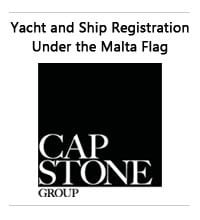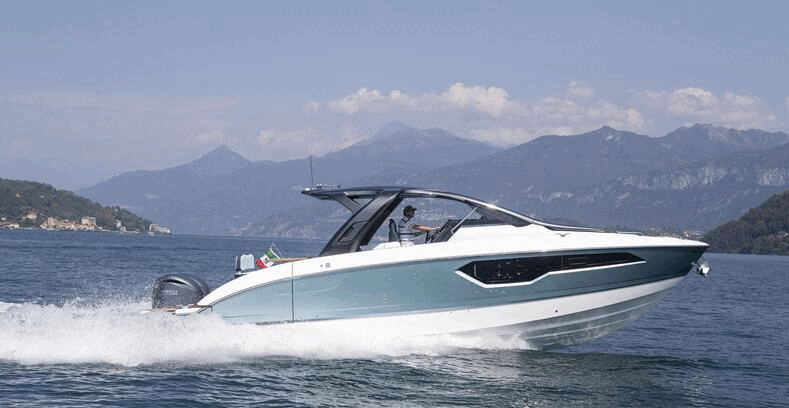Flagship motorboat line of the Beneteau Group, the announcement was made since the founding of the company back in 2009, that Monte Carlo Yachts will venture into super yacht size over 24 meters with this line and finally the project doing this comes from the fourth model, its upcoming MCY 86. The Monte Carlo MCY86 flagship follows the family feeling Italians from Venice designers Nuvolari Lenard created with the previous 76, 65, and 70 models. An original design which sets a lot of hybrid from other genres creating a unique fresh look outside which gets more imposing and sporty in this new flagship. That is at least what the above rendering transmits, thanks to a longer then usual fore deck, and a flybridge which looks lower due to the bigger size. Inside although no layouts seem to be shown as yet Monte Carlo will take a flexible semi custom approach; with choices for a three, four or five cabin versions being available. That is definitely very super yachts standard. The finishing of the interior will also come from highly regarded design firms with choices coming from Armani, Frau, Hermes, and Pierre Frey, this being added with the use of exquisite details as Venetian mosaics, cedar stone marbles, and Moka cream limestone. But other super larger yachts technical elements also are part of the MCY86 some coming as optional others as standard; like the Jacuzzi spa on the flybridge, the must have carbon made T-top with opening soft top, to the main deck large venetian doors, opening side bathing platforms, and the Portuguese bridge. Power is twin MAN 1800hp engines with estimated top speeds being at about 29 knots.
June 29, 2013
June 28, 2013
New Model: Grand Banks 50 Eastbay SX
Grand Banks 50 Eastbay SX is finally in the water! This new Grand Banks 50 Eastbay SX represents a more modern approach to the Down East lobster boat offer from this renowned boat builder, see new pilothouse side windows. But that only tells a small part of the 50 Eastbay SX and what it brings to the customers. Knowing well of the current market, the 50 Eastbay SX offers a lot of versatility to customers with five options for the main deck, and another same number coming to the lower cabin area. With all these offers you can nearly say the Grand Banks is nearly a custom boat. The 50 Eastbay SX standard plan is a two cabins with owners stateroom to fore, and U-shaped galley located below. But if this is not to your taste the different versions go on from moving the galley astern on the main deck, and also having an owners amidships stateroom replacing the fore. There is also a three cabin versions, with the third cabin being a bunk twin located to port side. As in newer Grand Banks and Eastbay models the 50 SX is fully designed around pod drives, but this time Grand Banks is using the Volvo IPS version with the 600 or 700hp units.
Technical Data:
LOA - 17.04 m (55.9ft)
Hull Length - 15.26 m
Waterline Length - 14.18 m
Beam - 5.03 m
Draft - 1.24 m
Displacement - 22,750 kg half load
Fuel Capacity - 3028 l
Water Capacity - 618 l
Accommodation - 4 berths in 2 cabins, 6 berths in 3 cabins
Engines - 2 x Volvo D11 600hp, D11700hp, MAN D2876 R6 800hp
Propulsion - Volvo IPS800 or 900 forward looking pods
Speed - 32 knots max 24 cruise with IPS 900 Volvo 700hp
Project - C.R. Hunt Associates Hull
June 27, 2013
Project: Clipper 39 Hudson Bay
Seems Clipper has received some nice reviews on the 50 Hudson Bay, and now the down under boat builder aims to follow this with smaller models. The 39 Hudson Bay like its bigger sister is a down East lobster design, offered in a fully enclosed hard top and patio door layout. Clipper main aim in this model was to create a one area between the aft deck and the interior of the pilot house. Below is an accommodation for four person with a master double berth to fore, and two bunk cabins located to port side. A shower head is located to starboard. A nice feature in the 39 Hudson Bay will be the L-shaped astern galley located by the patio door. Power is twin Yanmar 370hp engines with line shaft propulsion.
June 26, 2013
New Model: Albatro 45
Albatro presents a new model in the Rib series the 45. This new model continues the expansion of the Rib range from Albatro which features nine models which go up in size up to seventy feet. The 45 is an interesting rib cruiser which as other Lake Como builders follows the high performance heritage of Albatro, a winner in some important endurance championships. Albatro in-house design team in this 45 followed the family feeling shape coming from the 50 model. Performance boat but also a comfortable outside thanks to a huge central sun pad aft, and a dinette with opposite facing seats and a central table which from the floor. Inside is a cabin with a galley shower head, double Vee berth to fore, and two sofas which can sleep four persons. Engines are twin FPT 560hp units with surface drives propulsion, but choices start from twin 320hp units.
Technical Data:
LOA - 13.5 m (50.1ft)
Beam - 3.90 m
Displacement - 6 t
Fuel Capacity - 900 l
Water Capacity - 300 l
Max Persons - twelve
Accommodation - four berths
Engines - 2 x 320hp, FPT N67 560hp
Propulsion - Jolly drive surface drives, or stern drives
Top Speed - 55 knots max 45 cruise with twin FPT 560hp and Jolly surface drives
Construction - infusion build with vinylester resins and Kevlar reinforcements
Certification - CE B
June 25, 2013
Project: Back Cove 41
I never expected Back Cove to present a new flagship mostly because of its single engine ideals, but considering all why should not they do it. The 37 has been a success, and now the Rockland builder goes on to show a new 41 feet flagship. On the layout arrangement plans the Back Cove 41 offers a fully enclosed main deck with an aft cockpit having two L-shaped settees. Inside is a C-shaped dinette, with opposite galley and L-shape settee which will work well as a passenger lounge during trips or quiet area for reading at anchor. Below is a two cabins twin heads arrangement with the owners suite to fore. As with all the smaller Back Cove the 41 pays tribute to the down East designs with its single engine power, a predominant feature of most lobster boats from the past. The 41 is to be powered by a Cummins 600hp engine with line shaft propulsion.
June 24, 2013
New Model: Ilver 42 Mirable Open
It is always difficult to touch a born classic, and this is basically the story of the Mirable from Ilver, presented as 39 in 1991, reworked to 41 in 1999, and now after two decades of its productions becomes the 42. Few models have lasted so much as the Ilver Mirable and interestingly the same hull has always been used; extended about a foot with the 41 version below, and the super structure also changed next to little. This latest 42 version actually presents the biggest changes up top of the trio created in the past two decades plus, with some neat touches happening on the foredeck, restyled windshield which still respects the original, and changes to the radar arch which now seems more upright. The Ilver Mirable can actually taunt other models for being pretty much unchanged in twenty years plus, and not many builders can make such a claim in any of there models. The 42 Mirable Open comes from Ilver after the company presented the HT version a couple of years back, due to demand coming from the customers, and now the company presents these changes in this version. For the rest the 42 Mirable Open keeps the properties of its predecessors of a three double cabins lower deck still impressive considering the not so much beam, and a cockpit which would not look out of place in much more sports orientated boat.
Technical Data:
LOA - 12.87m (42.3ft)
Length Waterline - 10.00m
Beam - 3.62m
Draft - 0.63 m ex props
Displacement - 10 t
Fuel Capacity - 1000 l
Water Capacity - 250 l
Max Persons - eleven
Accommodation - 6 berths in 3 cabins
Engines - 2 x Volvo D6 330hp, 370hp, 435hp
Propulsion - line shaft, stern drive
Speed - 28 knots cruise
Construction - solid fiberglass bottom, with balsa core for sides and upper structure
Project - Sabrina Landoni and Gianni De Canio Design Group
Certification - CE B
June 22, 2013
Project: Numarine 105 HT
Numarine presents the project of the 105 HT, its sixth sport yacht and the largest to date. As is normal today the 105 HT will feature an invisible from the outside sport bridge with a central jockey helm surrounded by relaxing areas. Designers Tommaso Spadolini, Can Yalman, and Umberto Tagliavini make the best use of the exterior areas on the 105 HT, but below deck accommodation is also very interesting offering four large double cabins. Also spacious is the crew area with three double cabins all served with private heads, an L-shaped saloon and a large galley to starboard. The inside guest living offers a large saloon area served with two large sofas, and a central dining area located centrally to fore. Other interesting layout details is the L-shaped wet bar located by the patio door on the main deck, a day head, and an L-shaped mezzanine settee featured on the aft deck. Power is twin Cat 1825hp or optional MTU 2400hp. Top speeds estimates is a max of 30 knots with the standard engines.
June 21, 2013
Classics - Bertram 54 (1981 - 2001)
Picking a classic is always hard, and this becomes near to impossible when you mention a company like Bertram. The company Dick Bertram created, made waves in its start in 1960, thanks to the Ray Hunt designed 31 model. In those years Bertram and Hunt invented the Deep Vee hull, and also created production boat building as it is known today.
One can easily say that most of the models Bertram build up until the nineties can be regarded as classics nowadays. Still the 54 is one of Bertram's most iconic and admired models. In the people's mind the 54 is challenged only with the smaller and more affordable 31 sold in over 1800 units in its various versions for a production run lasting 23 years.
David Napier designed every Bertram from 1972 till 1998, with his first design being the 28 which was very much an inspiration to the Ray Hunt 31 which started the company. Born as a 53 project, for the Bertram 54 Napier set the trends in the sport-fish category creating the modern era of the genre, but also in yachts over fifty feet. Important note that since its launch the 54 is highly regarded as one of the most sea worthy yachts of its size and class even today thirty years plus after its launch. Considering that any sport-fish has to be a good ride that is high testament to the status the 54 has among this genre aficionados.
For the Bertram 54, designer David Napier followed what he started with the 46 a decade earlier with a modified Vee shaped hull featuring a deep entry and lowering itself to a medium aft dead rise of seventeen degrees. Napier and Bertram again made school and while the Hunt deep design was revolutionary in the 1960's, the 46 from Napier invented a more cruising approach to the Vee shape ideal suited for high cruise speeds and larger yachts of over fifteen meters and around the thirty knots range.
Accommodation wise the Bertram 54 was offered with three interior layouts all having three double cabins, and two or three heads. In a long term production run many make up changes were made over the years both inside and outside, with the most notable modernized fix coming in 1997 from Italian design firm Studio Faggioni.
The Bertram 54 had a production run of twenty years from 1981 till 2001, with the last decade being a start and stop situation build due to the luxury tax of 1993, and the negative effect this had on the North American boating industry in the period and the aftermath it left after.
One can easily say that most of the models Bertram build up until the nineties can be regarded as classics nowadays. Still the 54 is one of Bertram's most iconic and admired models. In the people's mind the 54 is challenged only with the smaller and more affordable 31 sold in over 1800 units in its various versions for a production run lasting 23 years.
David Napier designed every Bertram from 1972 till 1998, with his first design being the 28 which was very much an inspiration to the Ray Hunt 31 which started the company. Born as a 53 project, for the Bertram 54 Napier set the trends in the sport-fish category creating the modern era of the genre, but also in yachts over fifty feet. Important note that since its launch the 54 is highly regarded as one of the most sea worthy yachts of its size and class even today thirty years plus after its launch. Considering that any sport-fish has to be a good ride that is high testament to the status the 54 has among this genre aficionados.
For the Bertram 54, designer David Napier followed what he started with the 46 a decade earlier with a modified Vee shaped hull featuring a deep entry and lowering itself to a medium aft dead rise of seventeen degrees. Napier and Bertram again made school and while the Hunt deep design was revolutionary in the 1960's, the 46 from Napier invented a more cruising approach to the Vee shape ideal suited for high cruise speeds and larger yachts of over fifteen meters and around the thirty knots range.
Accommodation wise the Bertram 54 was offered with three interior layouts all having three double cabins, and two or three heads. In a long term production run many make up changes were made over the years both inside and outside, with the most notable modernized fix coming in 1997 from Italian design firm Studio Faggioni.
The Bertram 54 had a production run of twenty years from 1981 till 2001, with the last decade being a start and stop situation build due to the luxury tax of 1993, and the negative effect this had on the North American boating industry in the period and the aftermath it left after.
Specifications:
LOA - 16.46 m (54ft)
Beam - 5.16 m
Draft - 1.57 m
Displacement - 35 t
Fuel Capacity - 4500 l
Water Capacity - 950 l
Water Capacity - 950 l
Accommodation - Three different layouts. 6 berths in 3 double cabins, two or three heads version
Engines - 2 x GM 850hp, Cats 1400
Propulsion - direct line shaft
Speeds - 37 knots max with the later builds equipped with Cats 1400hp units
Hull Shape - modified Vee shape with forward 45 degrees entrance, and 17 deadrise aft
Project - David Napier hull and design, 1997 Studio Faggioni interior and exterior make up changes
Variations - forward windscreen option was possible in early models, later versions 1985 onward had no central pillar in side windows and produced in one peace, in 1997 studio Faggioni also changed the interiors and softened the design around the corners of the topside. The 1997 version is referred as the second series by the followers of the 54, although from .
Production Run - 1981 to 2001
Builds - 135
Developments - 1990 Bertram 60, and 2002 570 both use the David Napier hull of the 54 with some modifications. 570 had a complete new topside designed by Zuccon and renewed engine position and interior.
What Is Awesome
+ Broken Shear-line
+ Flybridge and main saloon size
+ Hull Lines
What Looks Dated
Small aft deck for a 16/17 meter recent sportfishing yacht
Square profile windows, especially the two parts of earlier models
What Is Awesome
+ Broken Shear-line
+ Flybridge and main saloon size
+ Hull Lines
What Looks Dated
Small aft deck for a 16/17 meter recent sportfishing yacht
Square profile windows, especially the two parts of earlier models
Used Price Range: from 150,000 to 400,000 US$. Very much subject to condition, and what needs to be done, as most units are from the eighties and powered by GM-Detroit.
Professional Tip: Many Bertram 54 interest come with the intent to refit. For this scout the market looking for a solid base especially on the engines and machinery side.
COMPETITOR - Hatteras 52 Convertible produced from 1983 till 1990.
* Please note that some Specifications are not from official sources and may not be accurate
COMPETITOR - Hatteras 52 Convertible produced from 1983 till 1990.
* Please note that some Specifications are not from official sources and may not be accurate
June 20, 2013
New Model: Prestige 450 Flybridge
Prestige has released some interesting new models in the past years showing some clever layout arrangements, a design stint which started with the project of the 58 launched as 60 and continued to evolve with the 500 series. The 450 Flybridge here follows the layout of the S of the same designation we presented a couple of weeks ago here on PowerYachtBlog with the added bonus of the helm and entertainment area up top. In the 450 Flybridge the fly deck is reached via a ladder to port side. The layout up top offers a helm to port side, C-shaped settee to aft, sun pad to fore, and a wet-bar to starboard, a conventional layout on most flybridge cruisers in this size nowadays. Inside the 450 Flybridge offers a nice main deck layout with the astern galley, while below is a two cabins with two separate entrances for the owners suite amidships, and guest cabin to fore. Power is twin Volvo 370 or 435hp engines with IPS pod drives which give a max speed of 33 knots.
Technical Data:
LOA - 13.96 m (45.9ft)
Hull Length - 12.56 m
Beam - 4.3 m
Draft - 1.1 m
Displacement - 11000 kg light
Fuel Capacity - 1200 l
Water Capacity - 520 l
Accommodation - 4 berths in 2 cabins, + 2 in convertible dinette
Max Persons - 9
Engines - 2 x Volvo D6 370hp, D6 435hp
Propulsion - Volvo forward looking dual propeller IPS500 or 600 pod drives
Speed - 33 knots max, 24 cruise
Range - 295 nm at cruise
Project - Garroni Design, JP Concepts, Prestige Engineering
Certification - CE B9, C10
June 19, 2013
Project: Viking 52 Open Bridge Convertible
Viking presents the project of a new 52 Convertible, another impressive addition to its world renowned stable of blue-water tournament contenders. As you would expect from Viking, this model evolves from recent introductions before it including like the 42, 55 and 62. The new Viking 52 will be built with a resin infused hull boasts a sophisticated matrix of composite materials including end-grain balsa coring, DuPont Kevlar, and knitted fiberglass laminates. The one-piece deck house assembly stretching from the bow pulpit to the inner transom liner features carbon fibre in its composite structure. A moulded fiberglass fore peak liner forward of the engine room sheds weight by incorporating the outer walls and floor, the lower port bunk, the sink base module and the shower pan for both heads, and the forward starboard bunk base. Maple lined interior hanging locker doors and cabinet and drawer fronts utilize a lightweight honeycomb core material. Continuing along its evolutionary trail, the forward entry is sharpened to knife through head seas. The convex hull shape adds buoyancy and moulded strakes on the bottom provide lift for planning efficacy. As a whole, these hull and the V-bottom features and the 11.8 degree transom dead rise, utilize horsepower most efficiently for better speed and faster throttle response in keeping with the theme of recent Vikings. The three-stateroom, two-head layout offers a choice of sleeping arrangements in the bow. The standard layout features crossover berths with the lower a double bunk and the upper port side berth a large single. This will be the stateroom layout on hull number one. A second plan is available offering a custom queen berth. On both versions, the master is fitted with a walk-around queen bed and is served with a private head and shower. A third stateroom to port has upper and lower berths. The port and forward staterooms are separated by a shared head and shower. Ample stowage is provided in the three staterooms with large maple-lined hanging lockers, credenzas, and deep drawer space, as well as beneath each bunk. A laundry centre in the companionway is standard. The salon is inviting and the area is well proportioned thanks to a five meters plus of beam for relaxation and entertainment with an L-shape lounge, a home theater system, a dinette, and an L-shape galley complemented with Amtico flooring, and an island fronted with a pair of bar stools. Rich Juno teak joinery and furniture throughout the yacht, custom designer furnishings and dry good create a spectacular aura of refinement and luxury. The large cockpit offers the convenience and comfort of our exclusive observation mezzanine, while the flying bridge showcases our exclusive centre console helm station arrangement with flanking lounges and forward seating. Engine choices include MAN V8 and V12 packages. Hull number will be powered with the large MAN 1400hp diesels providing a cruise speed of 35 knots and a top end of 40 plus, depending upon load, sea conditions and other environmental factors.
Subscribe to:
Posts (Atom)






























